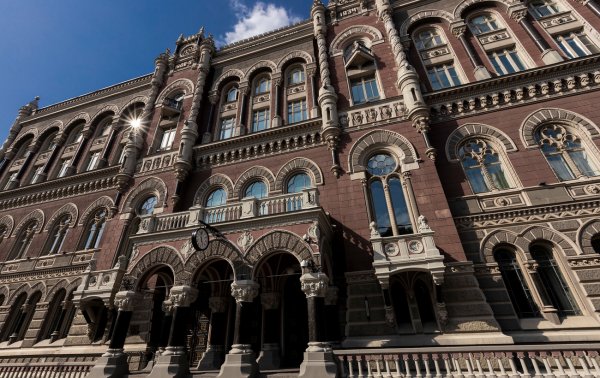
Photo: Most banks do not plan to raise interest rates on loans (NBU press center) Author: Dmitry Sidorov
Most banks do not plan to raise interest rates on loans, despite the increase in the NBU discount rate. The banking sector continues to actively lend to large businesses, develops programs to provide loans to the military, and attracts partners to reduce interest rates on loans.
For more details on the specifics of lending to legal entities and individuals, see the RBC-Ukraine article.
Content:
- The NBU discount rate and its impact on the cost of loans
- For what and to whom are loans given and for what
- Bank requirements for borrowers
- Credit products for military personnel
- What percentage of loans are not repaid?
- The Impact of War on Lending
The NBU discount rate and its impact on the cost of loans
To study key aspects of lending, RBC-Ukraine conducted a survey among large banks. The list of respondents included the following institutions: Oschadbank, OTP Bank, Pivdenny Bank, PUMB, PrivatBank, UnexBank and Raiffeisen Bank.
One of the key questions in the survey was the banks' policy regarding the interest rate on loans. This issue is especially relevant now, since in March the NBU raised the key rate from 14.5% to 15.5%. This step should increase the cost of money, and therefore reduce inflation. In theory, the growth of the key rate may lead to an increase in the rates on bank deposits and loans. However, most of the banks surveyed by RBC-Ukraine reported that they do not plan to change the interest rates on loans after the NBU's decision.
“The changes in the NBU's key rate that occurred this year did not affect interest rates for clients,” says Maksym Goncharuk, Project Manager of the Retail Business Sales Department at OTP Bank. A similar point of view was voiced to the publication by PUMB Bank.
Oschadbank noted that it actively cooperates with many financial partners, with whom it is possible to share risks and reduce the cost of loans. In particular, this is facilitated by cooperation with the European Bank for Reconstruction and Development and the European Investment Fund.

Photo: The National Bank raised the key rate by 1% to 15.5% on March 7 (NBU press center)
Head of the Credit Department of the Retail Products Development Department of UnexBank Alexander Alimov told RBC-Ukraine that the bank provides many consumer loans in cooperation with retail chains. These chains take on the payment of interest and commissions, and in return receive an increase in sales of their goods. This approach allows the bank to refrain from increasing interest rates on loans. He added that for commercial banks to increase loan rates, the NBU discount rate must increase by more than 1%, for example, by 2-3%.
At the same time, Pivdenny Bank noted that the increase in the key rate will still have an impact on the cost of loans from this financial institution, since its interest rates are tied to the level of the NBU key rate .
Most of the surveyed banks also reported that despite the war, demand for lending remains. “Demand for loans remains stably high. During 2024, PUMB's loan portfolio grew by 66%, while the overall market grew by 37%,” Dmitry Koval, Director of the Card and Passive Products Department of Retail Business at PUMB, told RBC-Ukraine.
What and to whom are loans given?
PrivatBank and Pivdenny Bank plan to maintain priority lending to large corporate businesses. In particular, Privat will focus on providing capital to agricultural companies, the food industry, and companies in the trade sector.
“Financing clients' energy projects is also a priority. Accordingly, we plan to actively increase the loan portfolio in the large business segment,” PrivatBank's press center reported in a comment to RBC-Ukraine, adding that the bank actively finances projects to create distributed generation in order to increase business energy independence.
Deputy Chairman of the Board of Pivdenny Bank Andrey Bukin said that in 2025, the key direction for the financial institution will be providing loans to businesses that conduct foreign economic activity, need working capital, and carry out foreign exchange transactions. The top manager predicts growth in the corporate loan segment in the banking system as a whole by 2025 by 15%. At the same time, Pivdenny Bank sets itself the goal of achieving growth at the level of 20-25%.
Raiffeisen Bank continues to provide loans to critical sectors of the economy, which is especially important in times of war. At the same time, UnexBank is expanding consumer lending . The bank recently launched a loan program where the client can provide his car as collateral. This product was implemented in cooperation with the Auto RIA marketplace.

Photo: Consumer loans are issued against the security of a car (Getty Images)
Bank requirements for borrowers
The most common requirement for future borrowers is a positive credit history, i.e. no debts, timely repayment of debts within the framework of cooperation with previous creditors. Of course, the borrower must provide a justification for his income or a business development plan that will generate the necessary cash flow.
“The ones who are refused are mainly those borrowers who have a negative credit history , an unstable financial situation, an opaque business model, or who create excessive credit risks when servicing the debt,” Natalia Butkova-Vitvitskaya, a member of the board of Oschadbank, told RBC-Ukraine.
In turn, Maksym Goncharuk from OTP Bank noted that a financial institution may refuse to provide a loan to an individual if he has a negative credit history and already has a debt amount that is difficult to service.
The war has made its own adjustments to the banks' policies regarding criteria for borrowers. According to Andrey Bukin from Pivdenny Bank, banks have begun to pay more attention to the geography of business and the quality of collateral.
Credit products for military personnel
Wartime also raises the issue of introducing preferential, affordable lending for military personnel, their families, people who returned from the war and want to start their own business. For this purpose, Oschadbank offers a special program “Business 4.5.0”, in which the above-mentioned categories of the population, as well as companies that employ veterans, can become participants. Within the framework of this program, the bank can provide a loan of up to UAH 5 million (for startups under a franchise for creating a business), and the possibility of attracting international grants and guarantees is also provided.

Photo: Banks are developing special preferential loans for military personnel and their families (Getty Images)
PrivatBank told RBC-Ukraine in a comment that the financial institution is actively participating in the state mortgage lending program, eHome, the largest share of whose clients are military personnel and their family members.
Raiffeisen Bank has a debit card called “Vdyachnost”, which veterans can use for free and receive special offers, discounts and cashbacks from the bank and its partners.
What percentage of loans are not repaid?
An important indicator of the banking business is the share of non-performing loans. According to the National Bank of Ukraine, as of February 1, 2025, this indicator among loans that were provided to the corporate sector amounted to 39.6%, and among loans issued to the population – 15.6%.
At the same time, PrivatBank, whose loan portfolio exceeded UAH 112 billion as of 2024, assured that the quality of the loan portfolio is gradually improving . The share of non-performing loans of the bank among business clients does not exceed 4-5%, and for some business segments this figure is below 2%. The same low figure is typical for mortgage lending.
Dmitry Koval from PUMB Bank also noted the improvement of financial discipline during the war years. In Pivdenny, they reported that the level of non-performing loans is only 5%, and Raiffeisen Bank noted that they are constantly working to reduce risks, which allows them to maintain a stable level of non-repayments.
Maksym Goncharuk from OTP Bank admitted that at the beginning of the full-scale war, the share of problem debt increased sharply – from 6% to 23%. “However, methodical and consistent debt settlement activities allowed us to stabilize the situation and reduce the volume of problem debt to 14% by the end of 2024,” he added.
The Impact of War on Lending
The war had a complex effect on the entire economy and the banking sector in particular. For example, Oschadbank increased its attention to risk assessment and tightened requirements for borrowers. The latter also became more cautious, although business is striving to expand, including through credit funds.
Interesting facts were cited by Alexander Alimov from UnexBank. According to him, since the beginning of the full-scale invasion, lending in Ukraine has been suspended for about six months. During this period, active communication with clients was conducted and, if necessary, loan restructuring was carried out.

Photo: At the beginning of the war, bank lending stopped altogether (Getty Images)
“Already six months after February 2022, banks, including Unex Bank, began to gradually restore lending to the economy. At the moment, all pre-war credit programs are working and new ones are being developed,” said a top manager of Unex Bank in a comment to RBC-Ukraine.
OTP Bank reported that they fully resumed lending to the population only in 2023 , when demand recovered and continues to grow.
Raiffeisen Bank noted that their credit policy is reviewed on a planned basis every year, regardless of the political situation and military actions. “When updating, changes in legislation, regulator requirements and recommendations of government agencies are taken into account,” the financial institution's press center explained.
The war and inflationary processes affected the credit policy of the banking sector. However, most banks left interest rates on loans at the existing level, the requirements for borrowers also do not change much, only some financial institutions began to take into account the geographical component. Banks are actively working to reduce the level of problem loans and maintain a focus on lending to both businesses and the purchasing power of the population.
